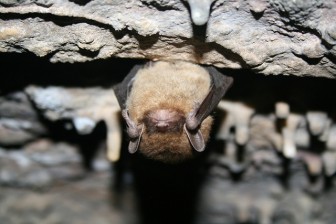By AMANDA PROSCIA
Capital News Service
LANSING — Little brown bat populations are unlikely to recover from a wide-spread fungal disease anytime soon, according to a recent study.
And if other bat populations follow suit, say goodbye to your margaritas! Bats are one of the largest global pollinators of agave – the plant that tequila is made from – and are diminishing quickly in the U.S..

White-nose syndrome has killed 98 percent of the little brown bat population.
Image: U.S. Fish and Wildlife Service
“White-nose syndrome is the biggest wildlife catastrophe in America in the last 100 years,” said Rob Mies, executive director of the Organization for Bat Conservation – a national advocacy group focused on the preservation of bats and based in the Cranbrook Institute of Science in Bloomfield Hills.
Although the report focused only on little brown bats, the model created by the study could be applied to all bat species affected by white-nose syndrome, said Wayne Thogmartin, a U.S. Geological Survey ecologist and one of the lead researchers on the study.
White-nose syndrome is caused by a fungus from central Europe. It first appeared in the U.S. in Howe
Caverns – a popular tourist cave in upstate New York. A tourist visiting the cave most likely unknowingly introduced the fungus to the cave through contact, Mies said.
The fungus grows in cold caves and mines and it negatively affects 25 out of 45 bat species, he said.
Mies said that once physical contact with the fungus is made and a bat is infected, it alters the animal’s metabolism, causing it to wake up mid-hibernation. It ends up starving and dehydrating before winter is over.
The new study modeled birth and death rates from previous research about Indiana bats and applied it to little brown bats. The researchers came up with three scenarios for their recovery:
• The disease is an isolated incident
• Lower reproduction and survival after the disease outbreak
• Smaller populations of bats increasing the chance of survival
Each scenario had the same result: It would take decades to recover from a disease that’s wiped out 98 percent of little brown bats.
“All the scenarios were washed away by the magnitude of the disease,” Thogmartin said.
Optimistically, little brown bats will start increasing reproduction sometime in the 2020s – but only if the disease is under control.
Not all species are affected by white-nose syndrome. But the condition is in Michigan — in both the Upper and Lower peninsulas — 29 other states and five Canadian provinces. It kills a million bats a year, Mies said.
Bats are more than Count Dracula’s alter ego – they play a crucial role in the ecosystems in the Great Lakes and globally.
They’re the primary predators of night-time insects, feasting on corn earworm moths and emerald ash borer beetles – two insects that could wreak havoc on Great Lakes region crops if uncontrolled. A 2011 study estimated that U.S. farmers save anywhere from $3 billion to a little more than $50 billion on insect control costs because of bats.
In addition to agave, bats pollinate more than 300 species of fruit, including bananas, mangoes and guava.
Bats also keep forest ecosystems healthy – something vital to states dependent on outdoor tourism like Michigan.
Research findings about the diminishing bat population have pressured state officials to promote bat conservation.
“It’s a realization that we need to do all that we can,” said John White, a biologist in charge of the bat conservation program at the Department of Natural Resources in Wisconsin, where white-nose syndrome was identified last year.
White said his department is taking an educational approach to prevent the fungus from traveling from site to site, including educating cave visitors about properly cleaning their footwear before they travel to another cave.
Mies said ecologists suspect that’s how the fungus was first introduced to caves in the U.S.
Researchers are testing treatments in the field, he said, including locations in Great Lakes states.
“The Great Lakes states are on the frontline of white-nose syndrome,” Mies said. “They’re right on the edge of mass deaths, so if we can stop it, it’ll be wonderful.”
Although officials are trying to manage white-nose syndrome at the state level, there are things ordinary citizens can do to help, he said.
• Replace dead trees with bat houses so bats have a safe place to raise babies.
• Replace lawns with wildflower gardens so bats have food.
“They need safe places to live and safe places to eat – so that way they can continue the ecological benefits they provide us,” Mies said.
Amanda Proscia writes for Great Lakes Echo.
ADDITIONAL RESOURCES FOR CNS EDITORS
Organization for Bat Conservation: http://batconservation.org/learn/threats-to-bats/
Map showing where white-nose syndrome has been found: https://www.whitenosesyndrome.org/resources/map.